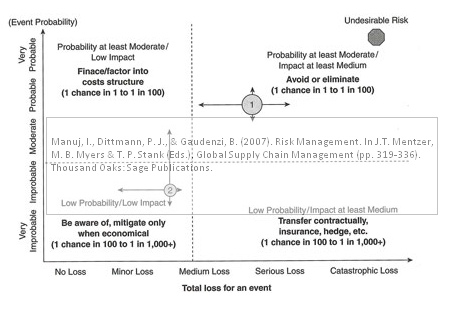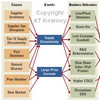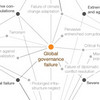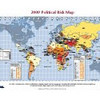 The Handbook of Global Supply Chain Management
The Handbook of Global Supply Chain Management is an excellent book. My interest in it stems from the fact that it contains a chapter on risk management. It was after reading Manuj and Mentzer’s articles on Global Supply Chain Risk Management and Global Supply Chain Risk Management Strategies that I came across this book, when searching for more papers from Mentzer and/or Manuj, and naturally, I decided to see if there was something on supply chain risk in it. There was.
Deja vu
Unfortunately, the chapter doesn’t say much more than what has already been said in the above articles. This book chapter follows more or less the same structure as the Global Supply Chain Risk Management article, it even uses the same figure, but it is better written and more geared towards the practitioner, with examples of how to put the model into use. Personally I find the book chapter preferable to the article.

Copyright note: The figure above is taken from the book chapter.
But – there is a very good reason to look closer at that chapter, it’s the figure above, illustrating how a risk matrix can be put to use when assessing supply chain risk.
Comprehensive
As to the rest of the book, it is to say the least, comprehensive, filled with 600 pages of intensely condensed knowledge, covering everything about Global Supply Chain Management from A to Z:
- Understanding Global Supply Chains
- Global Supply Chain Management Strategy
- Assessing the Global Environment
- Value and Customer Service Management
- Demand Management
- Knowledge Management
- Process Orientation
- Managing the Functions
- Marketing and Sales Management
- Product Management
- Operations Management
- Integrated Logistics Management
- Inventory Management
- Transportation Management
- Warehouse Management
- Supply Management
- Personnel
- Managing the Resources
- The Lean Supply Chain
- Financial Management
- Risk Management
- Interpretation Systems: Knowledge, Strategy, Performance
- Managing Relations
- Relationship Management
- Logistics Outsourcing
- International Sourcing
- Negotiating Throughout the Supply Chain
- Interfunctional Coordination
- Intercorporate Coordination
- Global Supply Chain Control
- Making It Happen
- Supply Chain Innovation
- Global Supply Chain Security
- Diagnosing the Supply Chain
- Change Management
More detailed information on the chapters can be found using the amazon.com “Look inside” preview.
Conclusion
The book comes with a hefty price tag, but reasonably priced used ones are usually available. Although I have focused solely on the chapter on risks, I did browse the other chapters, and I must say they are equally solidly written. It is handbook indeed, allowing the reader to focus on one area of investigation at the time, while never leaving the whole chain out of sight.
Reference
Manuj, I., Dittmann, P. J., & Gaudenzi, B. (2007). Risk Management. In J.T. Mentzer, M. B. Myers & T. P. Stank (Eds.), Global Supply Chain Management (pp. 319-336). Thousand Oaks: Sage Publications.
Author links
- wikipedia.org: John T Mentzer
- linkedin.com: J Paul Dittmann
- linkedin.com: Ila Manuj
- linkedin.com: Barbara Gaudenzi
Buy this book
- amazon.com: Handbook of Global Supply Chain Management
Related posts
- husdal.com: The risks of global sourcing












